
Still of Magdalena Suarez Frimkess from LACMA's film "Her Finest Disregard." (Photo credit: LACMA)
Sometimes, even collecting information about the art is an adventure of its own.
The first museum exhibition of L.A.-based and Venezuelan-born artist Magdalena Suarez Frimkess (b. 1929), “The Finest Disregard,” at the Museum of Contemporary Art features ceramics, paintings, and drawings, including works made collaboratively with her husband, Michael Frimkess, and some never-before-seen.
“We have more accurate information about the work; title, date, etc.,” José Luis Blondet, exhibition curator, told CALÓ News. “A big component of this exhibition was that kind of research; locating the work.”

Magdalena Suarez Frimkess, Mickey, 2004, collection of Ryan Conder. (Photo: Museum Associates/LACMA)
Blondet visited Magdalena after the pandemic when he noticed something behind an armoire. “She said, ‘Oh yeah, that’s an old painting,’ and then we were able to restore.”
Along with the support of Suarez Frimkess’ family, the exhibition also received help from artists who admire and have collected pieces of her art. “Almost all of the lenders for the exhibition are working artists in L.A.,” Blondet said. “Magdalena is an artist’s artist. Artists collect Magdalena’s work.”
Suarez Frimkess’ imperfect yet beautiful art is well-known for many reasons, one of them being her sculptures of cartoon characters such as Popeye, Olive Oyl, Donald Duck, Mickey and Minnie Mouse, Betty Boop, Felix the Cat and Porky Pig. Despite vaguely resembling the characters they are inspired by, the artist meticulously crafted these figurines to allow her humor to shine through like in “Mickey” (2004). Another medium of hers is drawing. In 2015, after breaking her wrist, the artist learned to write with her non-dominant hand which can be seen in her two “Drawing” (2015) works.
“Magdalena has been working nonstop for more than five decades, producing powerful work,” Blondet said. “[Her work] has not been silent, Magdalena has not been censored, but Magdalena has been an active presence in L.A. in a quiet way. That's why many artists collect her work, and I wanted to give her the stage so we can appreciate her work.”

Magdalena Suarez Frimkess, Untitled, 2013, Los Angeles County Museum of Art, gift of Jonas Wood and Shio Kusaka. (Photo: Museum Associates/LACMA)
Another reason Suarez Frimkess’ art has an ‘imperfect’ or beautifully rustic look is her refusal to learn how to wheel and her own special connection to traditional ceramic techniques. Not one of her hand-built teacups, bowls, carafes, or tiles look the same.
“Magdalena's pieces are very rustic, very imperfect. She's not seeking perfection. She's not going after a beautiful piece. She goes after something that, sometimes, is not that pretty. There is something ruined and that’s deliberate,” Blondet said.
“People think Magdalena is a self-taught artist or that she doesn't know what she's doing,” Blondet said. “‘Oh, that beautiful, old lady.’ No, she's very aware of what she's doing, and she's in control of what she does. Those ‘imperfections’ or those things that are not refined and polished are deliberate decisions that she has made as an artist, and that's why the show is called ‘The Finest Disregard.’”

Magdalena Suarez Frimkess, Untitled, 1972, Wood Kusaka Studios (Photo: Museum Associates/LACMA)
Despite spending a significant amount of her life in Chile and displaying her work all around the U.S. and Europe, Suarez Frimkess has always shown how proud she is to be from Venezuela. She makes references to the Venezuelan artists she studied with in her work. But Venezuelan people aren’t the only representations she weaves into her art. She has always supported the struggle of Black and Brown people living in the U.S., which can be seen in her portraits of Angela Davis and Martin Luther King, Jr.
Born in 1929 in Maturín, Venezuela as Maria Magdalena Suarez Matute, she grew up in a working-class family. At the age of nine, when her mother passed away due to tuberculosis, she was sent to a Catholic orphanage and, after finishing middle school, the nuns recommended that her father enroll her in art classes after recognizing her skills in draftsmanship. Soon after, while training as a lab technician, she also enrolled as a part-time student at the Escuela de Artes Plásticas de Caracas. It was there that Suarez Frimkess studied art alongside Rafael Ramón González, Rafael Monasterios, Mateo Manaure, Adela Rico Lander and Dora Helsen.

Magdalena Suarez Frimkess, XXL Minnie Mouse, 2009, collection of Karin Gulbran. (Photo: Museum Associates/LACMA)
She sold her first painting to Miguel Otero Silva, a writer, journalist, and politician who published a feature on her work in El Universal. In 1959, Suarez Frimkess attended sculpture, printmaking, and collage classes, while lecturing on the history of abstraction and Josef Albers’s theory of color, at Pontifical Catholic University.
During this time, the artist created surreal sculptures depicting the female body using what she calls “reverso con clay,” or the casting procedure in which an unfired clay form produces a negative form on plaster. This experience led her to a new project: filling pantyhose with plaster and displaying them suspended from the ceiling or hanging inside a wooden structure she created. The erotic connotation attached to these pieces caused a censorship issue at the University but didn’t affect her inclusion in a student exhibition in 1960. After receiving a fellowship from the Lebovitz Foundation for a residency at the Clay Art Center in Port Chester, New York, Suarez Frimkess settled down in the city with her partner Michael Frimkess before they moved to Venice, California, in 1971 and began collaborating.
Known for his advanced wheel technique, Frimkess’ structured vessels are wheeled and then handed off to Suarez Frimkess to paint without discussing a theme with him. Sometimes the images matched her husband’s style but, usually, she allowed the brush to freely paint.

Top to bottom: Magdalena Suarez Frimkess, Minnie Mouse Wearing Venice Canals Dress, 2004, Minnie Mouse Wearing Pineapple and Palm Tree Pattern, 2005, Minnie Mouse in a White Dress with Red Polka Dots, 2007, Minnie Mouse in a Green Dress with Pink Polka Dots, 2007, Minnie Mouse in a Pink Dress, date unknown, collection of Karin Gulbran. (Photo: Museum Associates/LACMA)
As a Venezuelan himself, Suarez Frimkess’ art resonates differently with him than it would with Latinos in the U.S., but her work is open to everyone who views it. “She’s an artist with a fantastic vision and an extraordinary ability to build these pieces that convey so many things in such a simple gesture,” Blondet said.
In addition to “Magdalena Suarez Frimkess: The Finest Disregard,” which will be on display at LACMA’s Resnick Pavillion until January 5.

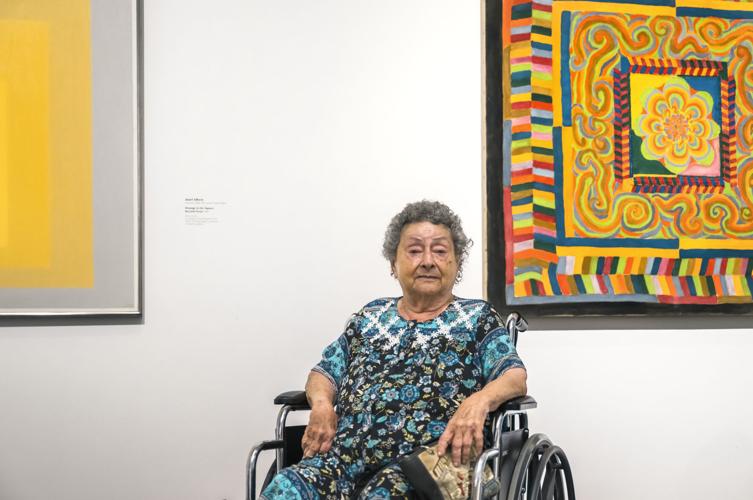
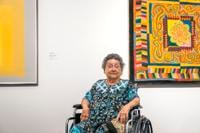

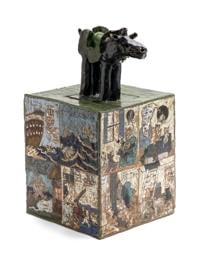

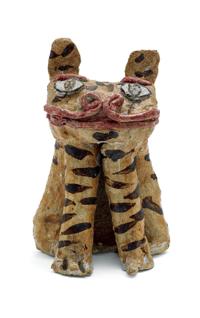

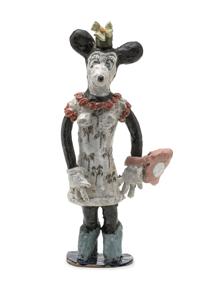

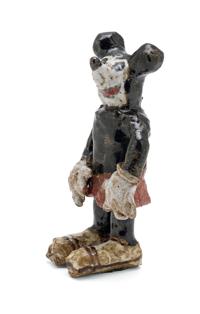











(0) comments
Welcome to the discussion.
Log In
Keep it Clean. Please avoid obscene, vulgar, lewd, racist or sexually-oriented language.
PLEASE TURN OFF YOUR CAPS LOCK.
Don't Threaten. Threats of harming another person will not be tolerated.
Be Truthful. Don't knowingly lie about anyone or anything.
Be Nice. No racism, sexism or any sort of -ism that is degrading to another person.
Be Proactive. Use the 'Report' link on each comment to let us know of abusive posts.
Share with Us. We'd love to hear eyewitness accounts, the history behind an article.